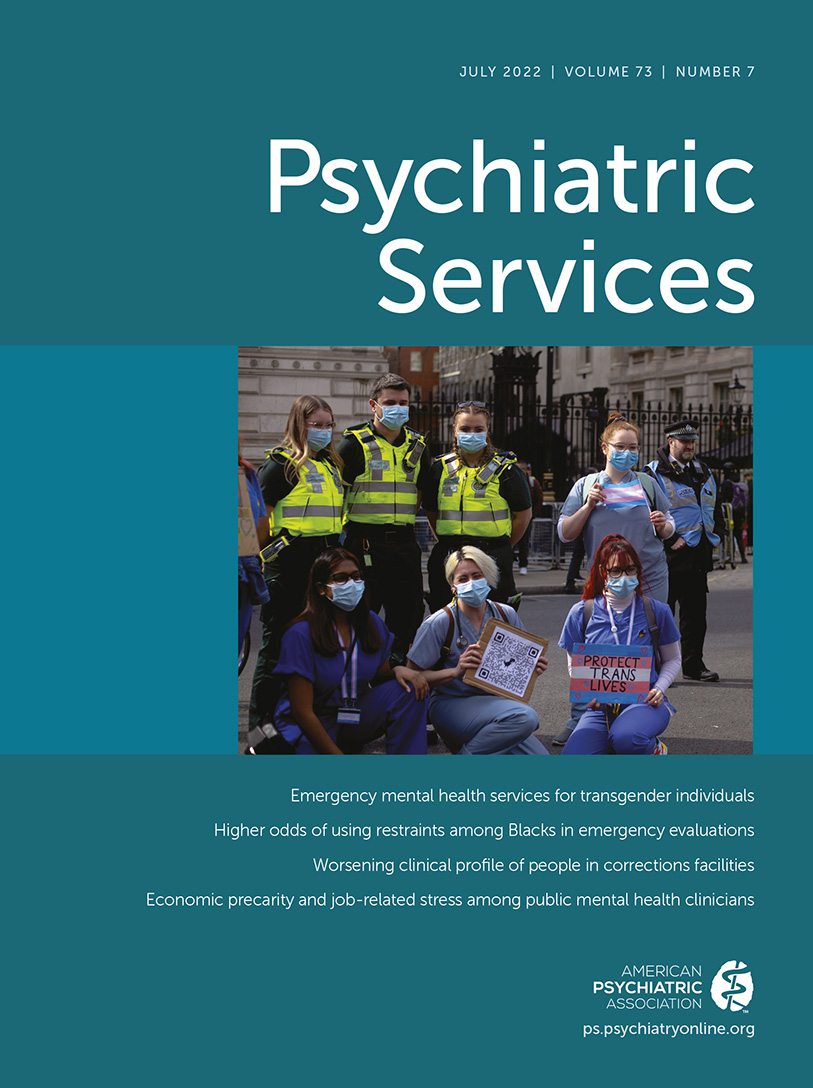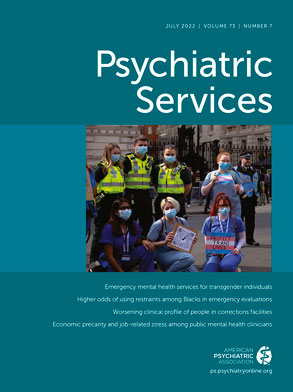A decade of criminal justice reform has started to chip away at the roots of racialized mass incarceration in the United States. Amid a reckoning with systemic racism, communities are questioning the corrective benefits of incarceration and are adopting reform strategies, including reducing reliance on police enforcement, reshaping prosecutors’ roles, and limiting pretrial jail detention. This should be good news for people with mental illnesses, who are overrepresented in the carceral system, particularly those who are Black or Latinx. It is estimated that 1–2 million people with mental illnesses enter jails annually (
1). These individuals are more likely to be detained pretrial, spend longer periods in detention, and face myriad collateral consequences when detained, including limited access to treatment and severed ties with community supports (
2). Although pretrial detention reform is a critical part of reform of the criminal legal system nationwide, there are early signs that it may have unintended negative consequences for people with mental illnesses. To minimize or avoid these consequences, we argue that mental health professionals must have a basic understanding of what pretrial reform entails and shift the way they work with some clients who are at risk for failure to appear to court.
Pretrial Reform and the Move to a “Managerial Model” of Criminal Law
Pretrial reform encompasses a range of strategies to keep people out of jail while they are awaiting trial, including eliminating money bail for most misdemeanors and nonviolent felony cases and implementing court date notification systems. In places like New York State; Philadelphia; Cook County, Illinois; and Harris County, Texas, new laws have eliminated the use of money bail and pretrial detention for most misdemeanors and nonviolent felony cases (
3). In New York State, in lieu of detention, anyone charged with a violation, misdemeanor, or class E felony (the least serious class)—aside from some exceptions—now receives a desk appearance ticket (DAT) upon arrest (
4). They are then required to appear in court for an arraignment appointment within 30–90 days. Recent analyses suggest that these reforms have significantly reduced pretrial jail populations without jeopardizing public safety (
3). For people arrested on low-level misdemeanor offenses (e.g., trespassing or shoplifting), this means being able to stay connected to one’s community, employment, and treatment providers while proceeding through the judicial process.
From a critical perspective, Yale lawyer and sociologist Issa Kohler-Hausmann (
5) writes about how misdemeanors are now the modal criminal legal system encounter in the United States. Calling on Foucault’s (
6) notion of “disciplinary power,” Kohler-Hausmann argues that lower criminal courts in places like New York City have largely abandoned the “
adjudicative model” of criminal law—“concerned with deciding guilt and punishment in specific cases”—and instead operate within a “
managerial model—concerned with managing people through engagement with the criminal justice system over time” (
5). This managerial model operates through indirect social control techniques that track defendants’ law enforcement contacts, monitor compliance with court schedules and orders, and escalate punishments for subsequent legal encounters or for failing to meet court demands (
5).
Implicitly, a managerial approach to justice may involve recognition that low-level offenses are the manifestation of social problems such as poverty and structural racism and are therefore less effectively or legitimately handled by traditional approaches to justice. Yet, the managerial model’s primary concern about an individual’s “governability and responsibility” has implications for people with mental illnesses (
5). After all, in this model, court proceedings can become extended evaluations of a defendant’s moral worth. Defendants have opportunities to prove rule compliance but also are given plenty of chances to fail. In New York City’s supervised release pretrial program, judges now release defendants to community monitoring in lieu of bail or release on their own recognizance. Judges then evaluate defendants over time on their abilities to satisfactorily follow program requirements. For those with a mental illness, in particular those with functional deficits, this moral “performance” period can be hard to abide by and may end in failure (
7).
People released pretrial, whether they have a mental illness or not, must at some point return to court. Thousands fail to attend these court dates each year. Criminal legal systems have historically responded by issuing punitive sanctions, including arrest warrants. Even though less overtly punitive methods such as court date reminders can serve as successful behavioral “nudges” (
8), it is reasonable to assume that these measures will not be sufficient to withstand the increased volume of nonattendance associated with pretrial reform. Again in New York City, where policy requires DAT issuance for a substantial subset of charges, higher DAT volume is associated with lower appearance rates (
9).
Unintended Consequences of Pretrial Reform for People With Mental Illnesses
A decreasing jail population is important progress. It should not be surprising, however, that certain trade-offs of keeping people out of jail—sanctions for failure to appear, enhanced supervision, or required programming—have a disproportionately negative impact on people with mental illnesses, particularly those from racial-ethnic minority groups. Multiple studies have reported no-show rates ranging from 10% to >60% for outpatient mental health appointments (
10,
11). More research is needed on what drives failure to appear in court for people with mental illnesses. One might intuit that the risk factors for nonappearance are similar to those for missed mental health appointments: long lengths of time between release or discharge and first appointment, substance use, psychosocial impairment, and living in disadvantaged neighborhoods (
12). This connection is supported by New York City data indicating that during pretrial interviews, those with mental illnesses scored lower on measures of community ties related to future court appearance (such scores are used to calculate failure-to-appear risk) (
13). Parallel mistrust of criminal legal and mental health systems may also contribute (
14,
15). The shared root causes of missed mental health appointments and failure to appear in court are important to recognize. Indeed, among individuals with mental illnesses and criminal legal system involvement, those who do not engage in treatment are more likely to be rearrested for small infractions than are those who do engage in treatment (
16).
It is clear that much work remains in creating a fair and reasonable criminal legal system. Limiting reliance on pretrial detention and offering people connections to treatment after criminal legal system involvement are positive developments. But it will be critical for communities to monitor how these developments play out over time. Recent examinations of New York City’s jail population data are troubling. After an initial statewide reform was passed in April 2019 and enacted in January 2020, the state enacted an amendment in July 2020 that rolled back some of these initial reforms and made more offenses eligible for bail. From April 2019 until the first COVID-19 outbreak in New York City in March 2020, the pretrial jail population declined by 40% (
17,
18). However, this pretrial population has steadily increased since April 2020 despite COVID-19–related public health guidance around the increased risks for COVID-19 spread posed by correctional facilities (
17,
18). Furthermore, the share of the pretrial population designated as Brad H—an indicator applied to those who receive mental health treatment on at least two occasions when detained—increased from 45% to 52% between March and November 2020 (
17). Additional empirical analysis is needed to determine the full impact of these amendments on New York City’s decarceration efforts. Still, such trends in one of the country’s largest carceral systems are concerning.
What Mental Health Professionals Can Do as Strategic Partners
Mental health professionals can use this moment to become better informed about their local criminal legal system and step up as strategic partners in helping clients meet its mandates—even, and especially, when it is a system that the professionals themselves want to reform. We propose three ways in which professionals might practically integrate pretrial considerations into the clinical encounter.
First, mental health professionals can ask patients questions about criminal legal involvement in everyday practice. This might entail asking about involvement when first meeting a patient and regularly following up about details such as court dates and case outcomes. Supportive psychotherapy, case management, and other strategies can include person-centered approaches to keeping court appointments. Clinicians might track and support court adherence similarly to how they monitor primary care services attendance. Making such conversations part of the routine therapeutic encounter both lessens the stigma of criminal and legal involvement and overtly recognizes the impact that legal cases can have on mental health.
Second, hospitals and clinics can develop systems that allow providers to stay apprised of criminal legal involvement. In New York, anyone can query a public database of court calendars for future appearances, including for DATs. Although such work may be difficult in fast-paced, high-volume, and disposition-focused emergency department settings, clinicians could prioritize queries among individuals with known histories of criminal legal involvement. Further, inpatient units and outpatient clinics could gather information routinely as part of comprehensive care planning. This sort of information gathering could help mental health professionals better partner with patients in reducing the likelihood of pretrial failure and subsequent reprimands such as jail time.
Finally, given the rapid pace of criminal legal system reform, research on the consequences of pretrial reform for people with mental illnesses is urgently needed. We must know whether such well-intentioned reform efforts are paradoxically exacerbating disparities for individuals with mental illnesses. Early research results indicate that pretrial reform in New York may be worsening racial disparities even as it reduces the overall population of people incarcerated in the state (
17). Meeting the needs of clients with serious mental illnesses and criminal legal involvement will require a deep commitment to improving the social determinants of health while also building a more just criminal legal system. This can be aided by national pretrial reform efforts. It can be further expedited by informed mental health professionals who are committed to helping clients navigate their local criminal legal system successfully in order to hopefully remain free of further criminal legal involvement.

